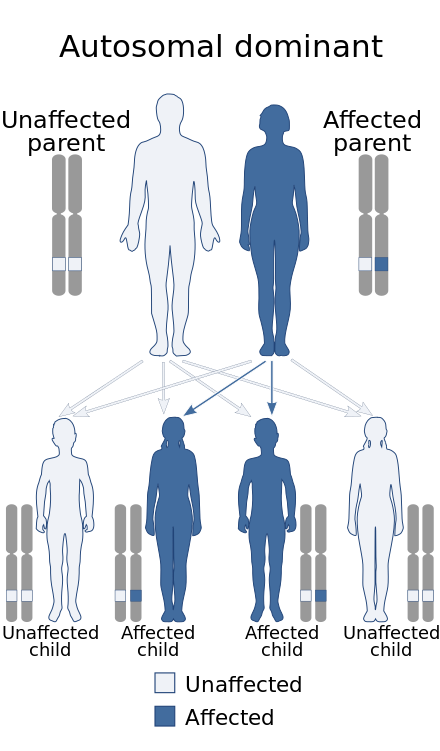Achondroplasia
Achondroplasia is the most common form of dwarfism, characterised by short stature due to disproportionately short arms and legs. It affects about 1 in 27,500 people and is caused by a mutation in the fibroblast growth factor receptor 3 (FGFR3) gene.

Signs and Symptoms
Key features of achondroplasia include disproportionate dwarfism, rhizomelic shortening (shortening of the proximal limbs), and short fingers and toes often forming a "trident hand" appearance. Individuals typically have a large head with a prominent forehead (frontal bossing) and a small midface with a flattened nasal bridge. Spinal issues such as kyphosis (convex curvature) or lordosis (concave curvature) are common, as are varus (bowleg) or valgus (knock knee) deformities. Frequent complications include ear infections, sleep apnoea, and hydrocephalus.
Children
Children with achondroplasia frequently experience delayed walking and motor skills due to reduced muscle tone. They may also suffer from bowed legs, scoliosis, arthritis, breathing problems, ear infections, and crowded teeth, which can be managed with surgery, braces, or physical therapy. Hydrocephalus, a severe complication, can occur due to cerebrospinal fluid buildup, often treated with shunt surgery or endoscopic third ventriculostomy.
Adults
Adults with achondroplasia are prone to obesity, sleep apnoea, and nerve compression leading to numbness or tingling in the legs. Psychosocial issues, including lower self-esteem and social challenges, are also reported. Pregnancy in women with achondroplasia is considered high risk, often necessitating C-sections.
Causes

Achondroplasia is caused by a mutation in the FGFR3 gene, which encodes a protein involved in bone growth. The mutation results in the protein being overly active, impairing the development of cartilage into bone. The condition follows an autosomal dominant inheritance pattern, meaning only one mutated copy of the gene is needed for the disorder to manifest. Most cases result from new (de novo) mutations, often associated with advanced paternal age. If both parents have achondroplasia, there is a 25% chance their child will inherit two mutated genes, leading to a lethal condition.
Diagnosis

Achondroplasia can be diagnosed prenatally through ultrasound or genetic testing. Postnatal diagnosis involves clinical assessment of characteristic features such as megalocephaly, short limbs, and mid-face hypoplasia. Radiologic findings show large skulls with narrow foramen magnum, short vertebral bodies, and a "trident hand" configuration.
Treatment
There is no cure for achondroplasia. Growth hormone therapy has limited efficacy, and vosoritide, a small-molecule drug, is used to improve growth velocity in children, albeit with unknown long-term effects. Limb-lengthening surgery can increase limb length, but its use is controversial. Management of complications such as obesity, hydrocephalus, and sleep apnoea is essential. Support groups and advocacy organisations play a very important role in providing information and support for affected individuals and their families.
Epidemiology
Achondroplasia is one of several congenital conditions with similar presentations. Prevalence rates vary, with studies reporting between 1.3 to 4.6 per 100,000 live births worldwide.
Psychological and Social Aspects
Individuals with achondroplasia often face psychological challenges, including lower self-esteem and social barriers. An accepting environment is very important for preventing social exclusion and promoting better outcomes. Support groups and advocacy organisations provide valuable resources and support for affected individuals and their families.
Self-assessment MCQs (single best answer)
What is the most common form of dwarfism?
Which gene mutation causes achondroplasia?
What is the typical inheritance pattern of achondroplasia?
Which of the following is a characteristic feature of achondroplasia?
What percentage chance does a child have of inheriting achondroplasia if both parents have the condition?
Which serious complication is common in children with achondroplasia?
What is commonly used to manage growth velocity in children with achondroplasia?
What radiologic finding is typical in individuals with achondroplasia?
What psychological issue is often reported among individuals with achondroplasia?
Which animal breed is known to have an achondroplasia-like condition?
Dentaljuce
Dentaljuce provides Enhanced Continuing Professional Development (CPD) with GDC-approved Certificates for dental professionals worldwide.
Founded in 2009 by the award-winning Masters team from the School of Dentistry at the University of Birmingham, Dentaljuce has established itself as the leading platform for online CPD.
With over 100 high-quality online courses available for a single annual membership fee, Dentaljuce offers comprehensive e-learning designed for busy dental professionals.
The courses cover a complete range of topics, from clinical skills to patient communication, and are suitable for dentists, nurses, hygienists, therapists, students, and practice managers.
Dentaljuce features Dr. Aiden, a dentally trained AI-powered personal tutor available 24/7 to assist with queries and provide guidance through complex topics, enhancing the learning experience.
Check out our range of courses, or sign up now!


